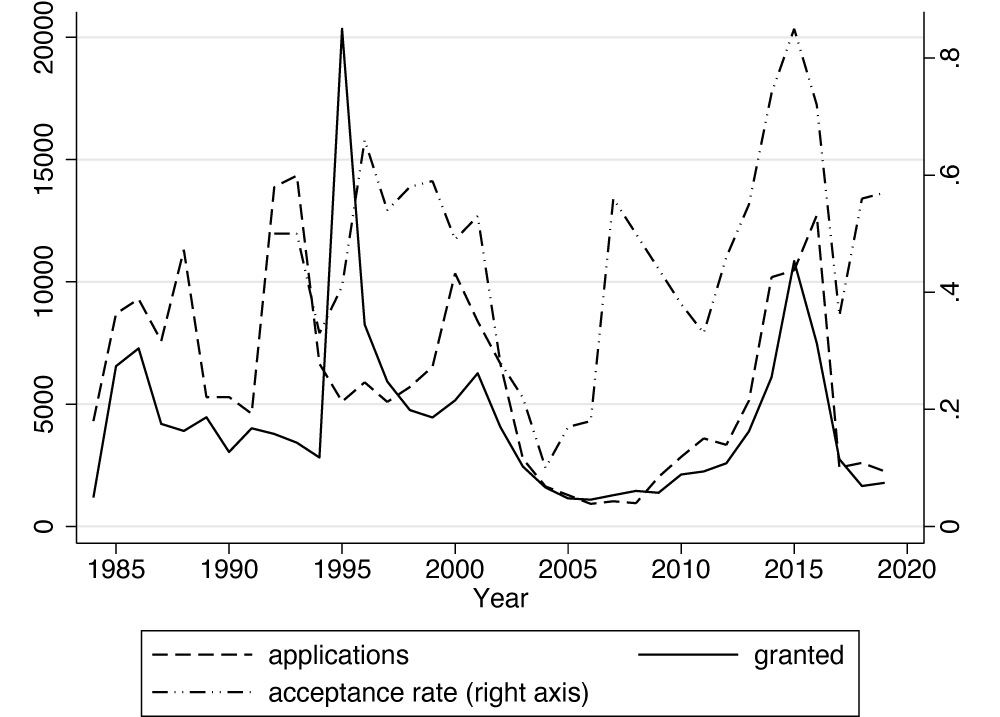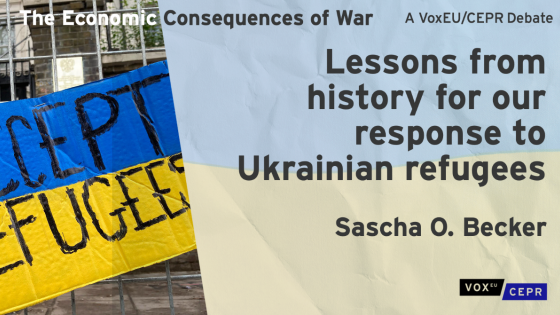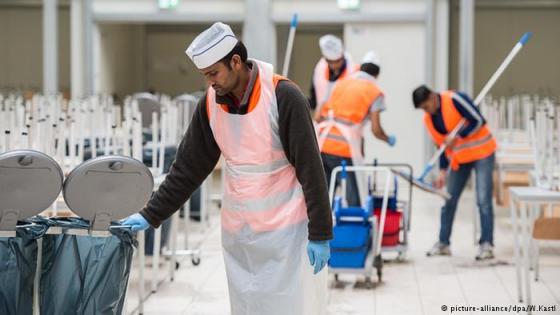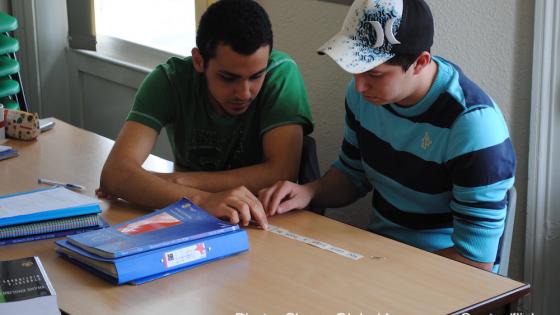Refugee immigration – defined as immigration that appeals to the 1951 Geneva Convention, its subsidiary agreements, and extensions of its interpretation – has received considerable attention in recent years (see Dustmann et al. 2016 for an overview). Many countries have introduced, or are currently discussing, reforms to their asylum procedures, the way they prepare refugees for the labour market, and how they administer transfers and financial support (Fasani 2016). To inform current policies, one can learn from past experiences. In a new paper (Arendt et al. 2022), we investigate the impact that different immigration and integration policies have on refugee immigrants, focusing particularly on labour market outcomes.
Learning from Danish refugee policies
The context of our study is Denmark, a country that has accepted refugees from a large variety of countries for more than four decades (see Figure 1). Denmark has also frequently changed policies and regulations concerning integration programmes, transfer payments, and conditions for permanent residency. Together with excellent administrative data, this provides a perfect laboratory to evaluate reform effects on refugees and their families, allowing us to study not only the immediate effects of discrete policies, but also how they affect outcomes in the longer run. We focus on four groups of policies and their effects on labour market attachment and performance of refugee immigrants:
- Dispersal policies for newly admitted refugees
- Employment support policies and language programmes
- Changes in welfare benefit transfers
- Policies that set out conditions for permanent residency.
We review existing studies that evaluated these policy changes and draw the following conclusions.
Figure 1 The number of asylum applications, those granted refugee status, and the acceptance rate in Denmark, 1984–2019
Notes: Asylum applications excludes applications from persons who are sent to other EU countries (via the Dublin Convention). ‘Granted asylum’ includes protection under the UN convention (inc. quota agreements), subsidiary protection, and protection for other humanitarian reasons. The acceptance rate is for applications for asylum on Danish territory under the UN Geneva Convention relating to the Status of Refugees (GCR) only.
Source: Arendt et al. (2022)
Dispersal policies
Newly admitted refugees are often subject to dispersal policies whose primary objective is to spread the burden of accommodating refugee immigrants evenly across the country that provides protection. Existing studies, however, show that refugees benefit from areas with large ethnic networks (Damm 2009) and better labour market conditions (Azlor et al. 2020), as well as from bigger cities (where opportunities to find jobs in high-wage industries are more abundant). In contrast, quasi-random dispersal may induce inefficiencies by preventing refugees from settling in areas where their skills are most employable and obtain the highest reward. Even worse, policies that allocate according to cheap housing – often correlated with local disadvantage – may lead to the long-term disadvantage of refugees.
Employment support policies and language programs
Based on our review of studies that evaluate employment support policies, including language programmes and job-training programmes, we find that on-the-job training promotes the employment chances of refugees, with job-training programmes administered early on being most effective in enhancing labour market entry (Arendt 2022). Studies also find that language programs enhance employment probabilities, although effects are found to materialise only in the longer run (Arendt et al. 2019). However, there is some evidence of a trade-off between job-training programmes and language programmes, where early job-training may delay the acquisition of language proficiency, which may then have detrimental longer-term consequences by obstructing access to higher level employment opportunities.
Welfare benefits and transfers
A reduction in welfare benefits and transfer payments is often advocated on the ground that it incentivises the labour market participation of refugee immigrants. Studies for Denmark that evaluate such welfare reforms indeed show a short-term response in employment probabilities, mainly for men (Dustmann et al. 2022a). However, such short-term responses do not carry over into the longer run and cease after five years. Moreover, the reduction in disposable income for affected households has several undesirable side effects, pushing many households below the poverty line and leading to higher criminal activity of refugees as well as their children (Dustmann et al. 2022b).
Permanent residency rules
Many countries have tightened the rules governing eligibility for permanent residency or citizenship in recent years, often motivated by a desire to provide incentives to integrate. The idea is that the economic benefits of permanence are so large that refugees – if tasked with investments into skills in exchange for permanent residency – will respond accordingly, leading to stronger labour market integration. However, this may only materialise if the bar for obtaining permanence is not set too high. Reviewed research shows that more demanding permanent residency requirements can indeed provide such incentives, but only if individuals believe they can fulfil the new requirements without overly large costs (Arendt et al. 2021). Otherwise, more severe requirements can lead to lower labour market performance.
So, which policies work and which do not?
Many of the policies discussed above share an aim to raise labour market participation, and we can compare their effectiveness in this dimension. As emphasised in several of the studies we reviewed, this requires understanding not only the short-term effects, but also the long-term response, as well as considering potential unintended consequences. Among the four broad groups of refugee policies evaluated in this study, only two produce effects that on average seem to outweigh costs: allowing refugees to choose where to settle, and active labour market programs that raise language skill investments. By contrast, policies that emphasise early job-training and policies that regulate access to welfare benefits or use permanence of residence to incentivise skill investment, while beneficial for some, create disadvantages for others.
References
Arendt, J N (2022), “Labor market effects of a work-first policy for refugees", Journal of Population Economics 35(1): 169–196.
Arendt, J N, I Bolvig, M Foged, L Hasager and G Peri (2020), “Integrating Refugees: Language Training or Work-First", NBER working paper 26834.
Arendt, J N, C Dustmann and H Ku (2021), “Permanent Residency and Refugee Immigrants’ Skill Investment”, The Rockwool Foundation Research Unit, Study paper 160.
Arendt, J N, C Dustmann and H Ku (2022), “Refugee Migration and the Labor Market: Lessons from 40 Years of Post-arrival Policies in Denmark", CReAM Discussion Paper 09/22.
Azlor, L, A P Damm and M L Schultz-Nielsen (2020), “Local Labor Demand and Immigrant Employment", Labour Economics 63.
Damm, A P (2009), “Ethnic enclaves and immigrant labor market outcomes: Quasi-experimental evidence”, Journal of Labor Economics 27(2): 281–314.
Dustmann, C, F Fasani, T Frattini, L Minale and U Schӧnberg (2016), “On the economics and politics of refugee migration", VoxEU.org, 18 October.
Dustmann, C, R Landersø and L H Andersen (2022a), “Refugee Benefit Cuts”, mimeo, UCL.
Dustmann, C, R Landersø and L H Andersen (2022b), “Unintended Consequences of Welfare Cuts”, mimeo, UCL
Fasani, F, T Frattini and L Minale (2020), “The scarring effects of employment bans for asylum seekers", VoxEU.org, 9 June.
Fasani, F (2016), “New eBook: Refugees and Economic Migrants: Facts, policies and challenges", VoxEU.org, 31 October.







